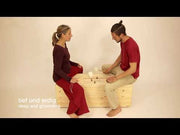Bass Tongue Drum - Ash Wood D-minor - special order only
This big bass drum with finely tuned tongues creates an energetic vibration It is designed especially for use by music therapists and is popular in kindergartens, schools and wellness, and therapy centers.
Playing this drum helps one to learn or teach about rhythm, communication (with two or more people) or connecting with the body through tuning into the drum’s vibrations.
You can turn the drum on its side and lie down on the surface.
The drum can be turned on its side, and a child or adult can lay down onto the surface.
These big drums with tuned tongues and energetic vibration were created especially for music therapists.
Feel the gentle deep rhythm whole-body (lying down) or interactive (two players sitting at the ends) or drumming naturally. Feel the sound here is palpable and very invigorating. 8 full-sounding tones made from the best regional ash.
Features:
-
tuned in D minor pentatonic
-
tone sequence: D - E - G - A - H - D - E - G
-
wood: lid - ash, body - pine
-
dimensions: 47 x 16 x 18 inches
-
Accessories: 2 mallets, hygrometer for humidity measurement
-
120cm long
-
NEW - disinfectable
-
Biologically treated with hard wax oil
-
Made in Germany
Open Tuning
What our customers are saying:
"I am always eager to discover new and interesting slants on existing instrument ideas. The quality and endurance of this Tongue Drum make it a great addition to my arsenal of instruments and sound colors, as well as being a fun source for children and the elderly alike"
Evelyn Glennie, Percussionist, Scotland
Application
The 8-tone bass-playing slit drum from feeltone is the first instrument with the "feeltone - idea" on the market. Feeling the rhythm while playing is so simply and uniquely realized here. The drum has feet on the bottom and on one side, so the instrument can also be tilted on its side and used as a lying version. There are two ways to experience the "feel the sound" principle:
Playing surface on top. Two players sit at the two ends of the drum, where there are no reeds, and play the reeds that are now in front of them with the mallets. Slowly it starts, the exploration - the vibration is perceived in amazement in the body and quickly the shyness dissolves and a joyful interactive drumming starts, at first not necessarily musical - the counterpart wants to be known - but later joyful, cheeky, funny, refreshing. Creativity is awakened and rhythm as communication connects and enlivens.
Playing surface on the side. The bass slit drum is tilted on its side. The lid is on the side, on top there is a blank pine side. This is padded with a blanket and a child or adult is placed on it. The legs can hang down or be placed on the drum. A player (companion or educator - or a practiced mindful child) sits next to the drum and gently strikes the individual sound tongues one after the other with a mallet. First you want to feel how the person is feeling, if that is OK - then the slow gentle drumming can begin. If you keep an eye on the breathing of the person lying down, the player can recognize what is going on in the person lying down and when it is enough.
The bass slit drum can of course also be played as a pure percussion melody instrument, as well as in a vertical position or as a bench. Caution - please do not sit on the reeds.
Use
In nursery schools, clinics, institutions for people with handicaps, this drum is very popular because of its "feel the sound" capabilities for mindfulness exercises and to experience one's own body as pleasantly perfused. Particularly with hyperactive children wonderful successes are to be registered. The attention goes from "being out of oneself" back to the inside, the body is perceived again, the system calms down and the child can be integrated again.
Tones
The 8 notes tuned in D minor pentatonic or A minor pentatonic are arranged in an order that the left hand starts at the lowest note on the left, then the next note of the scale is played on the next row of notes with the right hand, in this way it continues left - right - left and down again to the highest note. Arranged in this way, a clear sequence can be followed in rhythmic playing, but it is also possible to experiment intuitively with the timbres. Playing patterns that please are repeated, from time to time a tone breaks out and explores new sound fantasies. Beginning as a drum with rhythmic patterns that are staggered in time, melodies slowly build up. The bass slit drum can be played as well with mallets as with fingers and hands.
How to play
The mallets can be used to simply strike the notes rhythmically and clearly in succession. The player can also let the mallets drip on the notes, i.e. one lets the rubber ball of the mallet dop on the tongue and holds the stick in such a way, as if one wanted to remain on the tongue, thereby the soft rubber ball is sprung back. If you now let the feathering glide not only on one, but over several tongues, fascinating sound patterns are created, which can be combined with the simple striking of the tongues.












